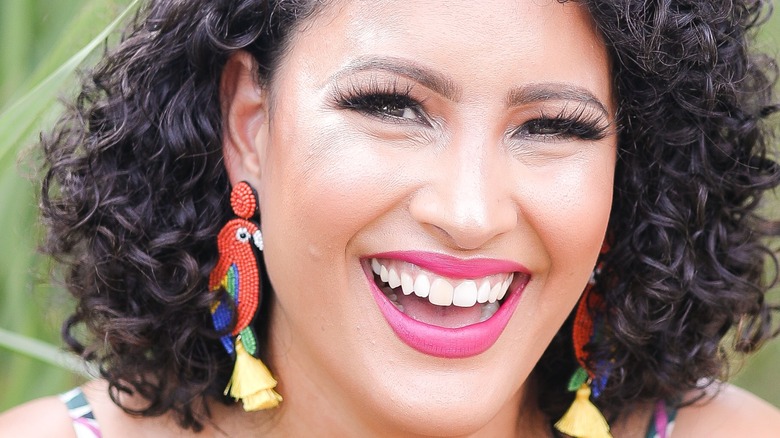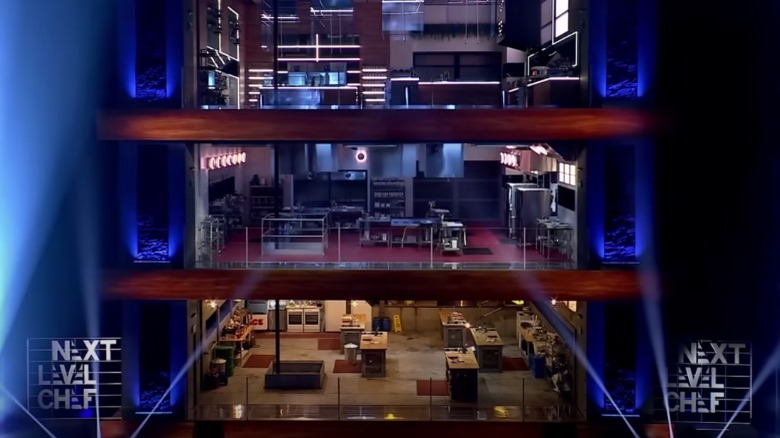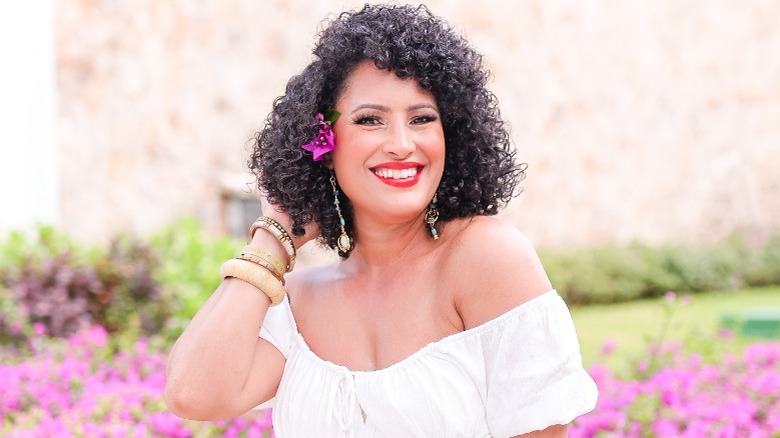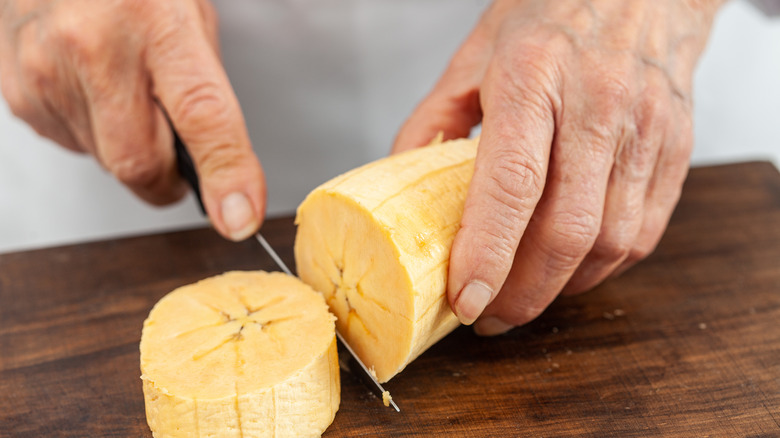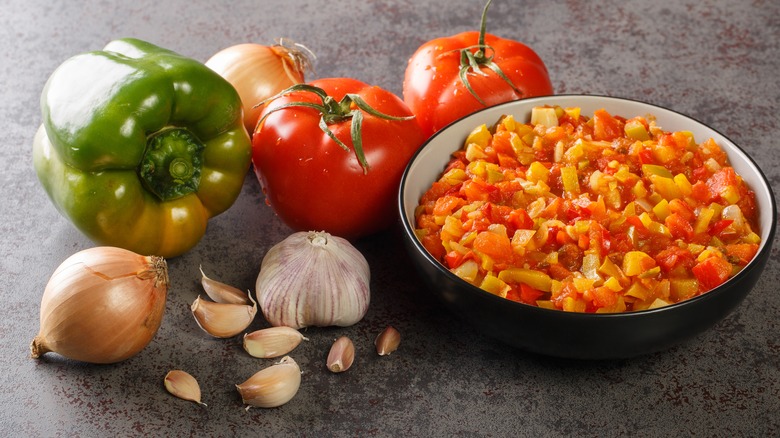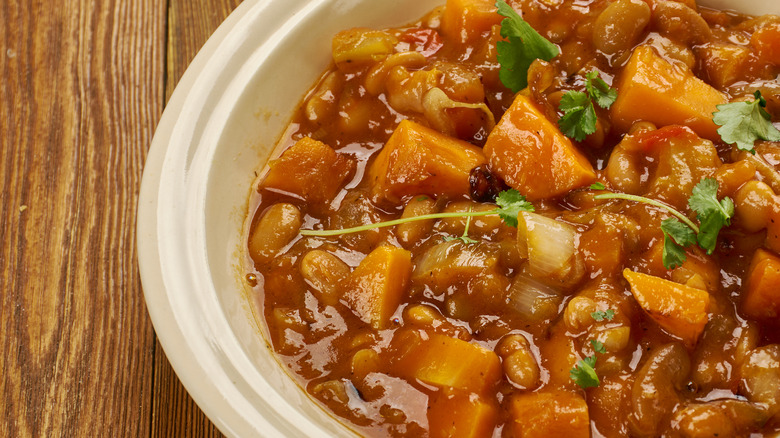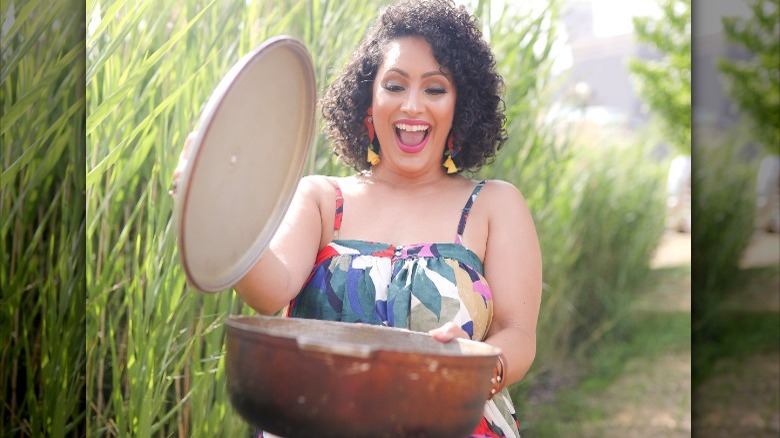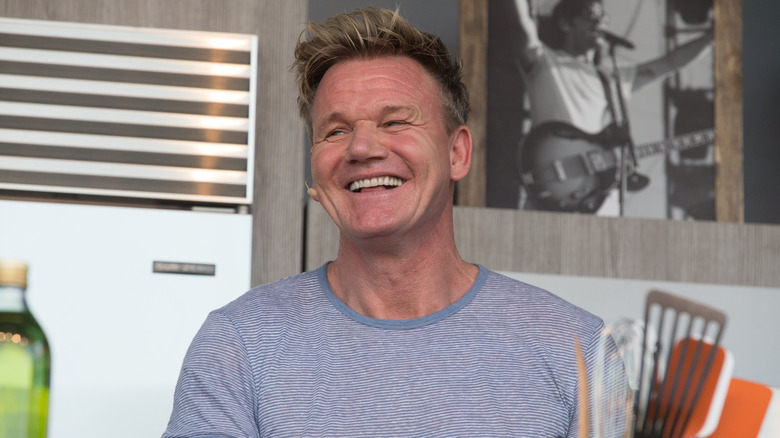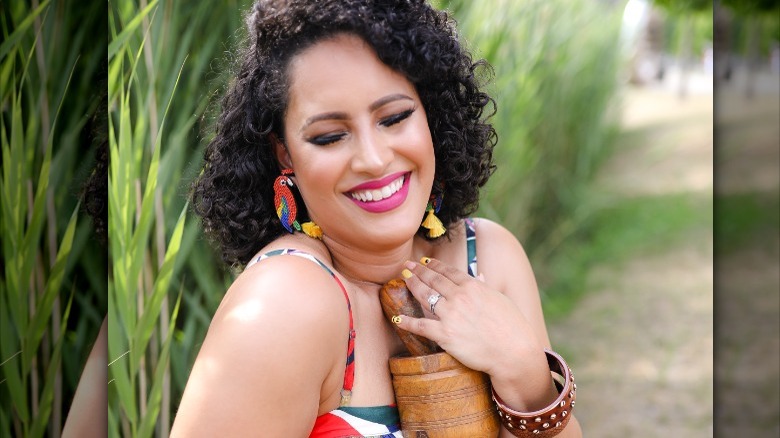Omi Hopper Brings Puerto Rican Flavors To Next Level Chef - Exclusive Interview
Omi (Omallys) Hopper is now in the spotlight. The "Next Level Chef" contestant from Providence, Rhode Island, had already caught the attention of the culinary-enthused on social media before flying to the U.K. to compete in Gordon Ramsay's newest competition; this kind of scrutiny, however, is unmatched. When Mashed talked to her the morning after Season 2, Episode 1 debuted, Hopper was just beginning to process it. "I haven't even gone on my social media platform because everything is [blowing up]," she told us. "My DMs, everything. I'm a meme. After Episode 1, I'm a meme-over saying, 'I'm Puerto Rican. I don't cook with yogurt' — and I really don't."
She doesn't, which would present a bit of a conundrum while competing. The "Next Level Chef" cabinets, Hopper confided, were painfully short on basic Puerto Rican staples like garlic and cilantro. But the social media sensation refused to give up — instead, she buckled down and made her own adobo seasoning. "I'm like, 'My flavor profile is not going to change,'" Hopper said.
That decision wasn't about not knowing how to cook another way. Instead, repping Puerto Rican island cuisine is Hopper's raison d'être, which is abundantly clear in the exclusive first look she gave us about her experience on the reality show.
What a day on the set of Next Level Chef is really like
Take us through a typical day filming for "Next Level Chef" — from waking up to going to bed.
This was probably one of the most challenging experiences of my life, and I'm a mom of four, so that's a lot to say. First of all, because we were not filming in the U.S., they were basically responsible for us. We had a wellness team that was in charge of us. I didn't have my own room key, let alone have access to my own stuff.
But a filming day would start ... We would start downstairs in the lobby of the hotel by 7:30 a.m., on the bus by 8:00 to be at the studio by 8:15 or 8:30. We wouldn't be back until about 8:00 at night. It was very long days of filming. Overall, the experience was incredible but exhausting, and it plays mind games on you.
What were you eating during filming?
We were fed very well. Whether or not you liked the food, that's a whole other story ... It got to the point where when I would cook on set, I would put a little bit of food aside so that I could eat.
What were they giving you?
We had the hotel breakfast. But while we were on set, right behind there was a shared lunch space that was there for the crew, plus for us as the contestants, so we could order. A lot of the chefs that were cooking there [were] professional-trained chefs, but the culture is very different because we were in the U.K., so food was a little bit different from what we were used to as U.S. contestants.
How Omi Hopper found out she'd actually made it on the show
18 of 24 of you made it from the hotel to the actual first episode of "Next Level Chef." What was that about, and what was going through your head?
The day before Episode 1, we all had a pre-photo shoot and pre-interview, and it was the first time that the contestants were meeting each other. We got to talk to each other ... This is a competition show, but these people are the only people in the world that are living this with you, because you don't get to share this with anyone else until we have the green light. Immediately, you make such a connection with them ... The casting directors did such an amazing job of getting all of us together. We were a great group, and I'm not saying that to be biased ...
We were told from before, "There's 24 of you, but that's in case somebody gets sick, in case somebody doesn't make it, in case somebody's flight gets canceled ... but only 18 of you are going to make it to Episode 1." I was like, "What do you mean?" So the pressure is on. I remember being told, "If by 8:00 a.m. tomorrow morning, you don't hear a knock on your door, assume that you're not one of the 18."
Instant bubble guts — instant hot and cold feelings. You're like, "What is going on?" And ... as I'm a woman of faith, I believe that if I can speak it into existence, it is going to be. That night, we finished all the photo shoots and we finished the video shoots, and I went back to my room. I did my hair. This is a process, by the way — this hair has its own personality ... I decided that I was going to iron my pants, but the nerves ... I'm using a hair dryer that's not my own; it's the hotel hair dryer. I'm putting my diffuser [on them]. I create this big cloud of smoke, the alarm goes off, and I'm like, "What the heck am I doing?"
I start ironing my pants. I'm so nervous, I burned my pants. It was literally out of a movie. You would think that I was in some sort of horror movie ... Then I heard a knock on the door ... It's one of the producers. They come in with their assistant and [say], "Please have a seat." They said, "... I want to be the first one to say that you are in Episode 1."
I almost fell out of my bed. I don't know what to say. I was so honored. It was such an amazing experience. But it plays tricks on your stomach for sure. You're up and down; you're everywhere emotionally.
How to master Omi Hopper's favorite Puerto Rican dish
You say that all 18 of you [contestants] are in a group text. What were you talking about after the first episode aired?
Personally, I have not had the opportunity to respond to anything. Today is — what? — it is 2:09 p.m., and you are the first person that I'm talking to outside of my circle that keeps me sane. I have not spoken to [anybody]. I haven't even gone on my social media platform because everything is ...
Blowing up.
My DMs, everything. I'm a meme. After Episode 1, I'm a meme-over saying, "I'm Puerto Rican. I don't cook with yogurt" — and I really don't. What are you going to do? At this point, I don't even remember saying that, by the way. I don't remember. It was so much happening in one single day that I was, "When did I say that? When did I grab yogurt?" When I finally saw it on camera, I'm like, "There it is, I grabbed the yogurt." It was insane.
You showcase Puerto Rican classics as taught by your mom and your grandma. What dish brings out the most nostalgia for when you were spending summers at your grandparents' farm in Puerto Rico?
My top favorite was viandas con bacalao, a mix of root vegetables — yuca, yautia, malanga, batata — these amazing root vegetables that are seasoned with a salted cod fish in a very soft vinaigrette with onions and peppers and garlic. It's a warm hug for me every time.
If we want to make this as a recipe at home, can you give us your top tips?
Less is more. My grandmother would always say, "Cut your vegetables fresh." She would always make us sofrito fresquesito. She would cut her vegetables nice and fresh and add those ingredients. Less is more ... ingredient-wise and what you're adding to that soft vinaigrette. You taste earth when you're tasting this dish, and that's why it's one of my favorites.
Omi Hopper's masterclass in sofrito
Can you give us a mini tutorial in your sofrito? You say that the way you cut your vegetables is important. Can we dig into that?
Mi sofrito fresquesito was actually one of the first videos that went viral for me on TikTok ... Sofrito is a base to a lot of Latin American dishes. In Puerto Rican cooking, it is the base of cilantro, culantro, garlic, onions, Puerto Rican sweet peppers — or aji dulce — and bell peppers. You could have green or red bell peppers. This gets blended into a paste, but you want to still be able to see the little chunks of these vegetables. That's going to be your cooking base for any stews, for any meats, for any rice and beans. It's always going to be the base, and the aroma that you get from the cilantro and the culantro and all of those spices ... it's incredible. It truly is a taste of Puerto Rican food.
How should we be cutting the vegetables?
When you're cutting the vegetables, you're really quartering them before throwing them into your food processor. The reason for that is ... obviously, to save space in the food processor, but also, it's what allows for the breakdown of the vegetables to not be so watery. You also don't want it to be dry, so it has to be just right. Most people would probably think, "Oh, I'll blend the onions all together, or I'll blend all the cilantro altogether." But [a sofrito] truly depends on how you blend all of the ingredients together in the food processor so that it actually gives you the perfect outcome of the perfect sofrito.
Stop believing this about Puerto Rican food
What are the biggest misconceptions that people might have about Puerto Rican food or Puerto Rican food culture?
The biggest misconceptions are that our flavor profile is [all] the same, right? Because, "Oh, it's just plantains and meat," or "It's just rice and beans," or "It's just rice and meat." The flavor profile might be similar, but the ingredients are used in so many different ways. I can make plantains in 25 different ways. I can make rice and beans 25 different ways.
I can make chicken — I can make stewed chicken so many different ways, maybe with the same flavor profile, but definitely, we'll have a different outcome depending on one or two ingredients that I may switch here and there. I can go from pollo guisado to a pollo en fricasé by adding grape juice, wine, and beer, and still having the sofrito, the tomato paste, your garlic paste, your oregano. There's so many ways of expanding the way you look at rice and beans. It's not just rice and beans — there's so many different ways of experiencing that.
Let's dig into rice and beans. What makes a plate of Puerto Rican rice and beans Puerto Rican and not from another place?
Our favorite one is arroz con gandules, which is pigeon peas. [With rice and beans you could use] pink beans, you could use black beans, you could use red beans, even Roman beans. But we use arroz con gandules. It's usually enjoyed around holiday time, but we have it whenever we feel "cuando me lo diga mi corazón" — we have it whenever we want it.
For arroz con gandules, the base is always going to be sofrito. Then you've got your tomato paste, you've got your adobos, sazón, oregano, your olives, pitted olives with your pimientos marrones or roasted bell peppers ... There's a way of making that specific rice, and even how we decorate the rice. The pigeon peas go in your rice — medium grain white rice is what is preferred on the arroz con gandules. Then you want to decorate it with — not just for decoration, but also for an added flavor — plantain leaves. Cover it with plantain leaves and add those bell peppers, cut them into thin slices, and make a nice little rainbow out of them. It's so beautiful; it's so flavorful. It's pretty to look at and it's wonderful to eat.
The surprising ingredient in Omi Hopper's pantry
Take us into your kitchen. What ingredients do you most rely on, and are there any we might be surprised to find?
Yes. I love mi sofrito fresquesito. I cook with sofrito all the time. I love garlic. Garlic, for me — we're best friends. We don't measure that. You let your heart choose how much you're going to put into your food. But you'd be surprised to find me using rice vinegar. I love using rice vinegar, like an Asian cuisine type of rice vinegar. I love the flavor and love, love, love what it does to my meats, so I use that.
For your meats, how do you use that?
If I'm going to be making en bistec encebollado — like an onion steak — rather than adding regular distilled white vinegar, I would use rice vinegar. It changes the ... It gives it a little sweeter taste. There's something in there that really changes for the bistec encebollado, and it's so much more flavorful.
That's a good tip. Now, you were not using the ingredients you normally work with on "Next Level Chef" at all?
Girl, listen here, let me tell you something. Between not having sofrito — and barely finding garlic — I'm like, "Where the heck is garlic? They hide it, where is it?" I'm looking for peppers, looking for cilantro. I'm like, "Where's my cilantro? I got nothing green here." There's so many times that I'm like, "Okay, we're going to make our own adobo." I would be the first person to run to the spice cabinet to grab all the spices and make my own adobo and start from there. I'm like, "My flavor profile is not going to change. This is what we're going to do."
You were on Nyesha Arrington's team. What's the number one thing you took away from her while working with her?
Oh, man. She is tough, but she leads with the heart. She's so good at knowing when to jump in and see the need. She sees the need and she feels it, in such an amazing way. She truly does lead with the heart where she's correcting you and she's being tough about it, but you know it's coming from a place of love, and you know that it's coming from a place that she wants to see you do better. I appreciated that about her a lot.
Omi Hopper decodes Gordon Ramsay's terminology
You quipped that Gordon Ramsay loves to joke around. Can you give an example from filming?
He's a jokester. He's sarcastic, but he makes you laugh. The spontaneity is superb ... There were so many times where he would come up and say something, and I'm like, "Is he being for real?" I wouldn't know. But when you start to learn his sense of humor, he's pretty awesome.
It's all a blur now, and it's been months since filming — so no pressure — but do you have a particular moment in mind?
In Episode 1, actually, there was one particular comment that he made that wasn't added to the final editing ... You have to think of the competition as a true mentorship. What you see on camera is the shortened version, but while we were living there in real life, it was a true mentorship for real. When he gave feedback about our food, it was to help us grow, and it was to help us get to the next level. There was one comment that I remember on my very first dish, which was, "It's a little clunky but sowa," and I remember that clear as day. He's like, "It's a little clunky but sowa."
I was like, "What does that mean?" You had to see me — I was looking around like, "What does that mean? What does that mean?" He has his own terminology for how he describes the food. But again, it comes from a good place, and it's to help you grow. If you've been in the kitchen as long as these chefs have been in the kitchen, you're tough. [To] get very far ... you got to be made of steel. Otherwise, it's going to eat you alive, especially in a competition like this.
What does it mean when Gordon Ramsay says that something is clunky?
I learned that in essence, I was plating like a Puerto Rican. I show my love by how much food I put on the plate — too much food on the plate, basically. I'm like, "Okay, I got it. I'm serving like a Puerto Rican." All right, note taken.
What's next for Omi Hopper?
Did you watch the first season of "Next Level Chef"? If so, how has the season changed with the immunity pins and all this stuff that they've done?
I watched Season 1 seven times before going away ... I got the email August 11. I was on a plane September 11. In that whole four-week time period, I watched Season 1 seven times, because at this point, I was studying it. At this point, I wanted to see what the girls were wearing on their feet. I'm like, "Okay, what shoes should I wear? Do they have earrings? How are they wearing their hair?"
Then, "What are those ingredients? Wait, I don't think I've ever cooked with that." [I was] learning that and discovering, and then getting there, [they] flip the whole thing on us. [I was like], "This is not exactly what I saw." I'm like, "Oh, so this is how you play mind games with us. It's nothing like Season 1." The immunity pin, saving your team, those are things that I wasn't [prepared for] ... "What do you mean?" You're running around, and you look like a chicken with a head cut off — that was me. That was totally me.
After having completed the show, what's your dream scenario? What are the projects you would love?
My dream scenario would be for me to continue to educate on my culture and traditions and our food. Caribbean food is so rich, but Puerto Rican food in specific, we don't get enough of a light. I would love to be that light ... I would love to see a line of spices, cooking spices that would be on shelves that would be natural and healthy for our people, and that people could enjoy and feel like they're eating good stuff and they're tasting grandmother's food as they're trying it.
I would love to see more of me on the big screen. That would be a lot of fun. A cookbook for sure — I get asked for a cookbook all the time. The day I ever write a recipe book — oh, my Lord. The way people ask me for a recipe book is insanity. But I would love to have not just a recipe book, but a book that tells a story along with it. That's in my heart's desire.
Follow Omi Hopper's journey by tuning in to "Next Level Chef" on Fox every Thursday night.
This interview has been edited for clarity.
